VIDEO
https://youtu.be/4DK3-krzDC4
TRANSCRIPT
Preface: Before undertaking the writing of our own textbook series, we want to first create a syllabus incorporating what is, in our opinion, an excellent book for learning how to listen intelligently to music: *What to Listen for in Music*, first edition published in 1939. The author, **Aaron Copland**, was an established and internationally successful composer in his own time.
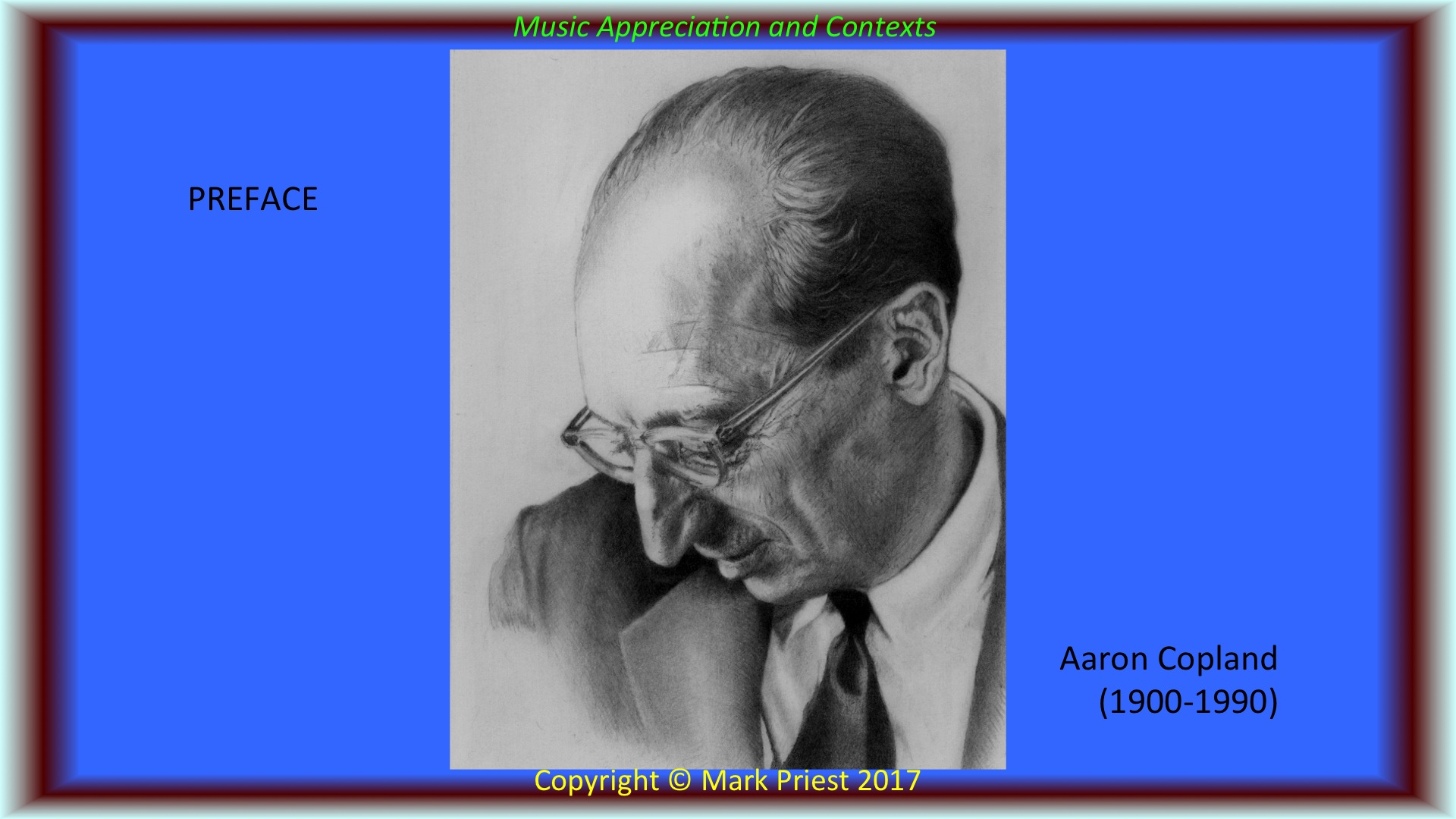
Finding an early edition of this book in my father’s library, I recall reading through it as a teenager. This planted seeds of wanting to become a composer. Though the seeds lay dormant for decades – due to circumstances and lack of encouragement – I would reflect back on what the author had to say about the inner workings of concerto grosso, fugue, about symphonic development, tone poems, and Leitmotifs, and many works of celebrated composers. There is a reference to this book in the Description box, along with a list of other works consulted. I suggest that students obtain and read through Copland’s book.
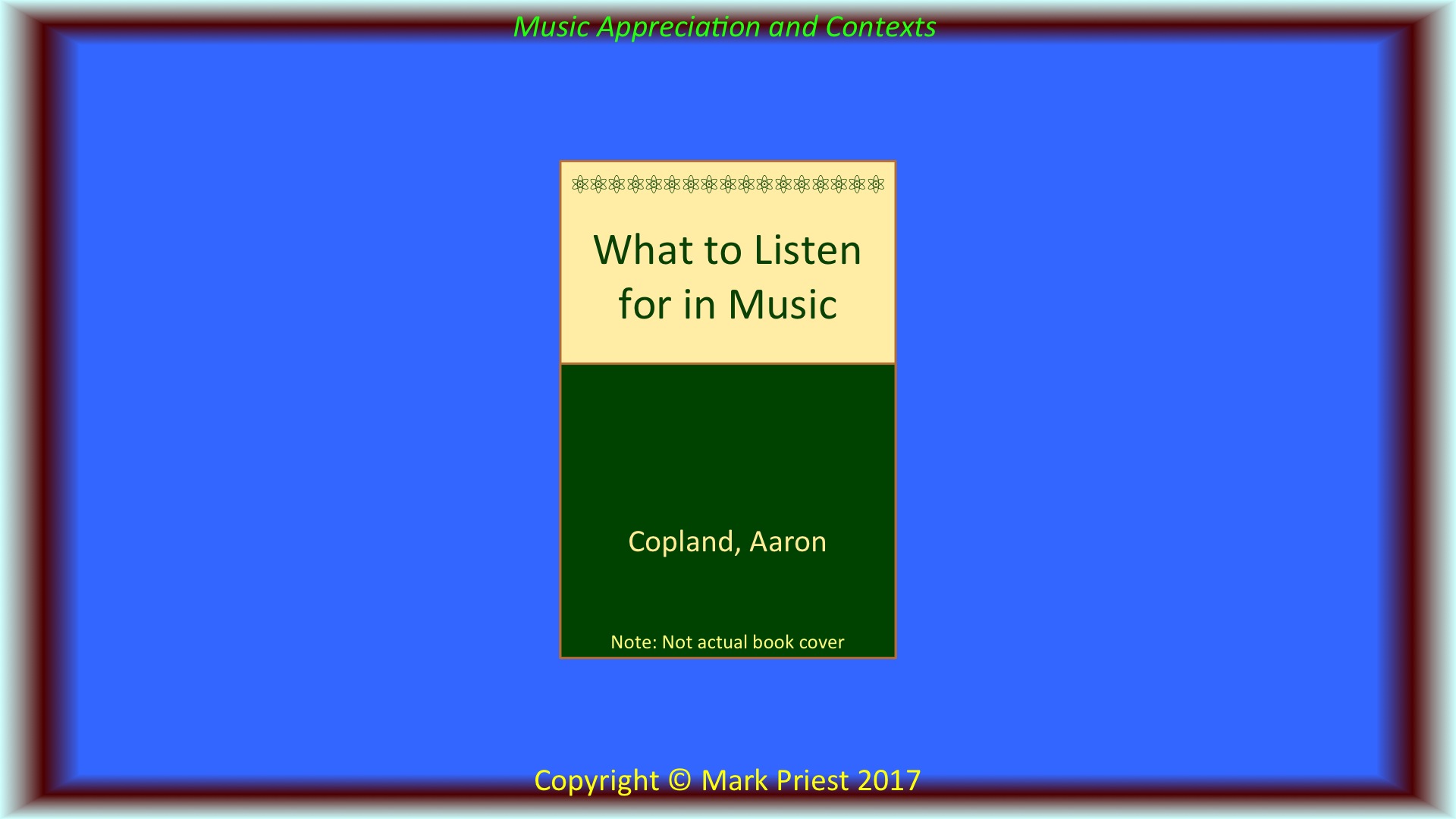
So without further delay, let’s delve into what is presently a very much Copland-influenced essay on ***Music Appreciation and Contexts***. The main highlights will discuss how to listen to music, and why, also the various contexts nurturing real world music creators, their environment: the **Where, When, Who, and What.**
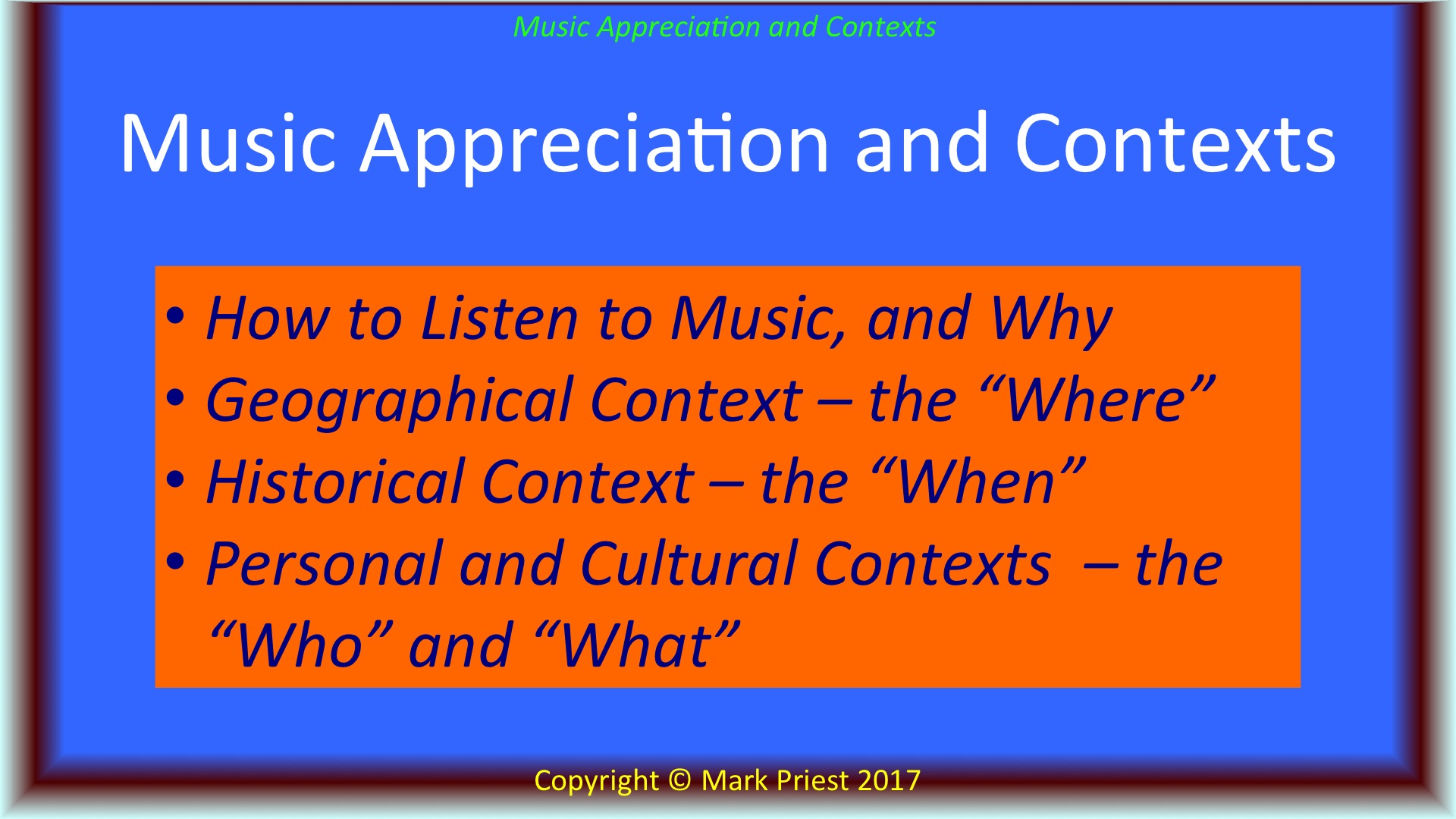
Attending a course on the appreciation of music and its contexts is of little value to us, unless we also do a lot of actual LISTENING to the music we’re studying.
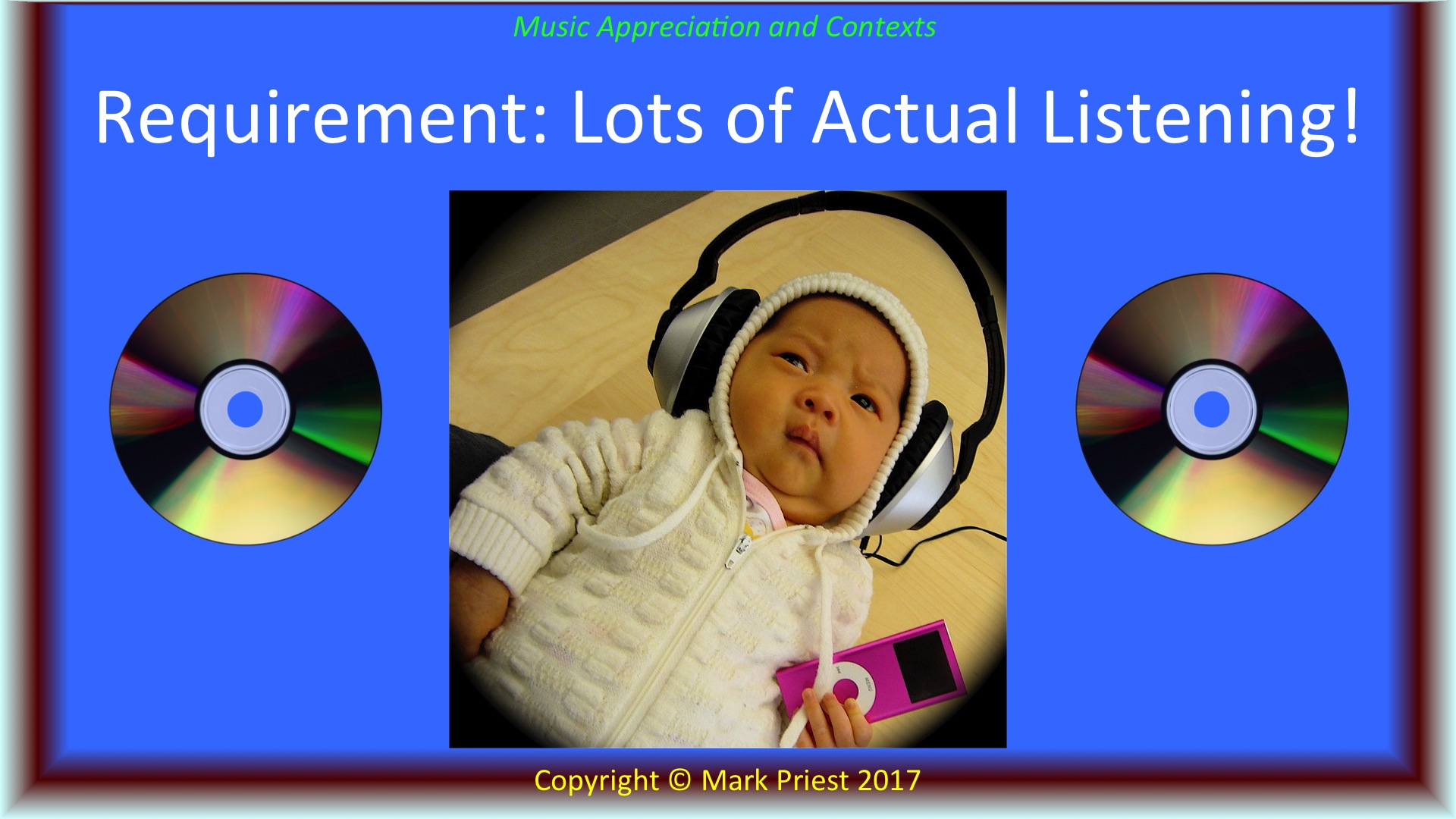
Music is much more accessible today, with the advent of various audio and visual media: from tapes to discs, to digital storage devices, to internet video sites, as well as movies, video games and television. It is actually difficult to *avoid* hearing music these days!
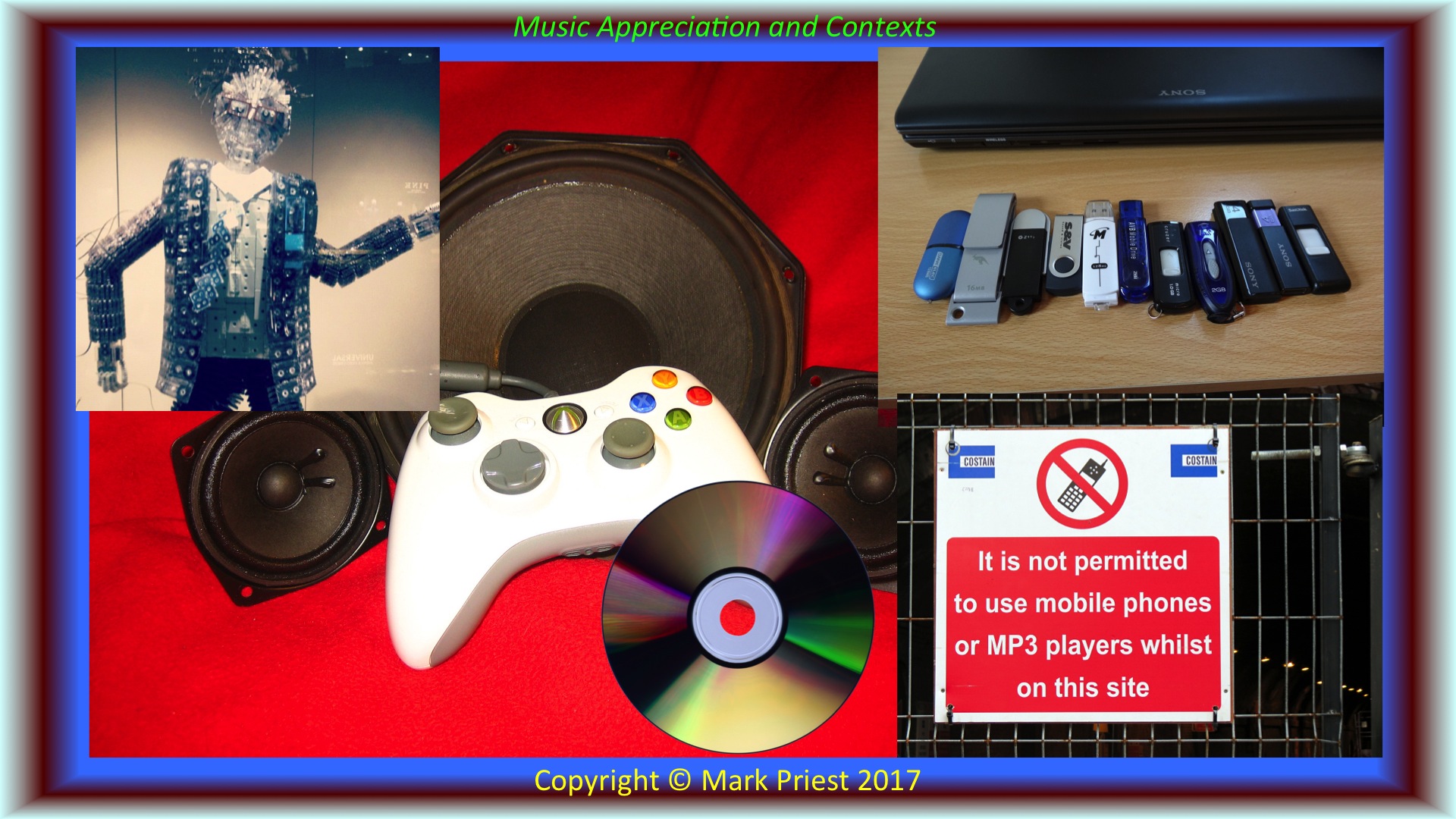
As far as possible, we will provide links and references to online and recorded performances of the music we examine, but bear in mind that links may eventually change or expire.
Aaron Copland wrote that, even though we may ‘object that we don’t understand music’, yet we never say that about a book we might have read. If you can read and come to understand a great work of art literature, say, *Julius Caesar*, by William Shakespeare, even though you are not yourself a writer …
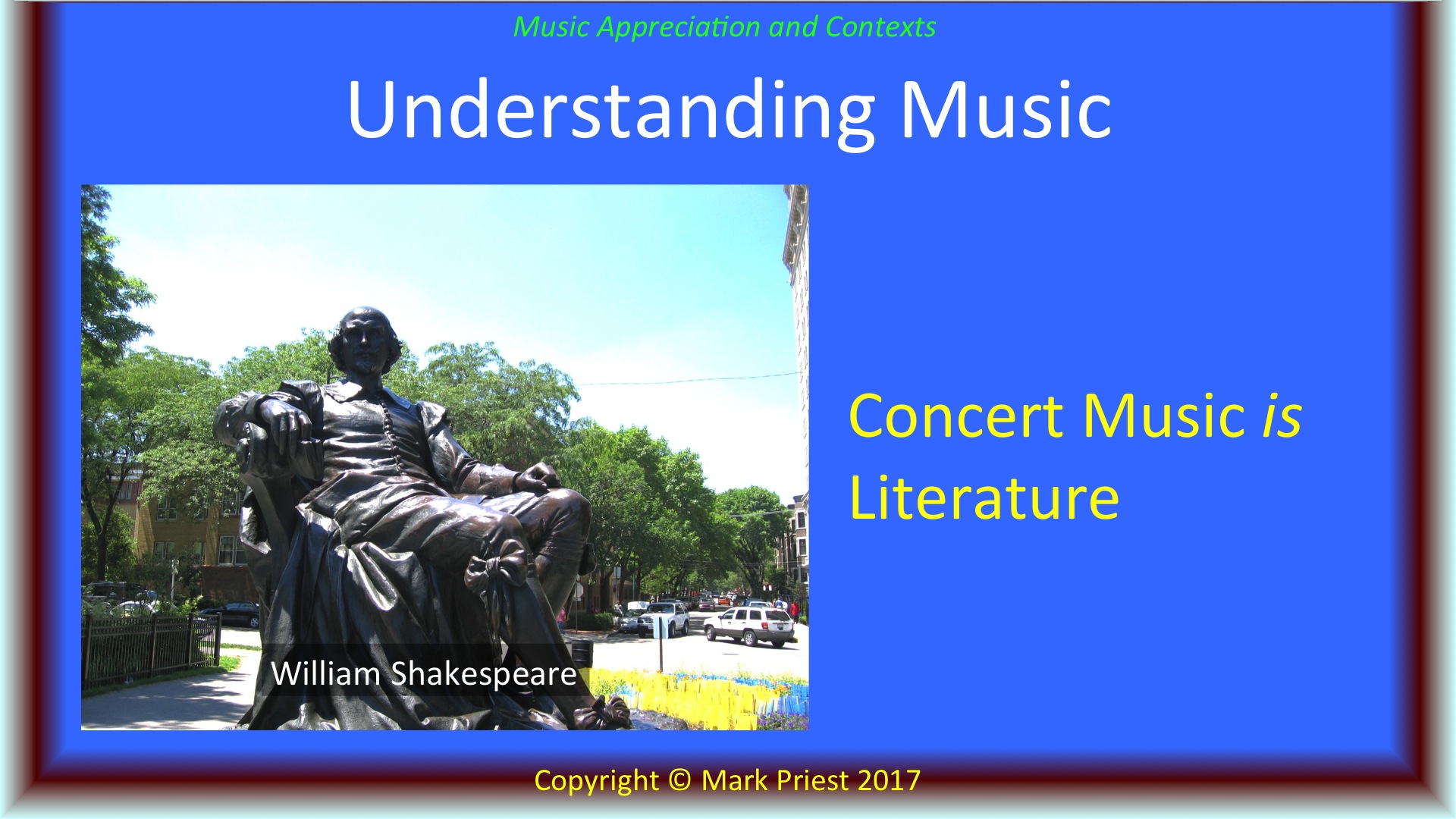
… Then even if you are not a musician, you can learn to listen to and appreciate a complex piece of concert music. Do not underestimate the ability of your ear-brain processing center to understand the music you hear in this course.
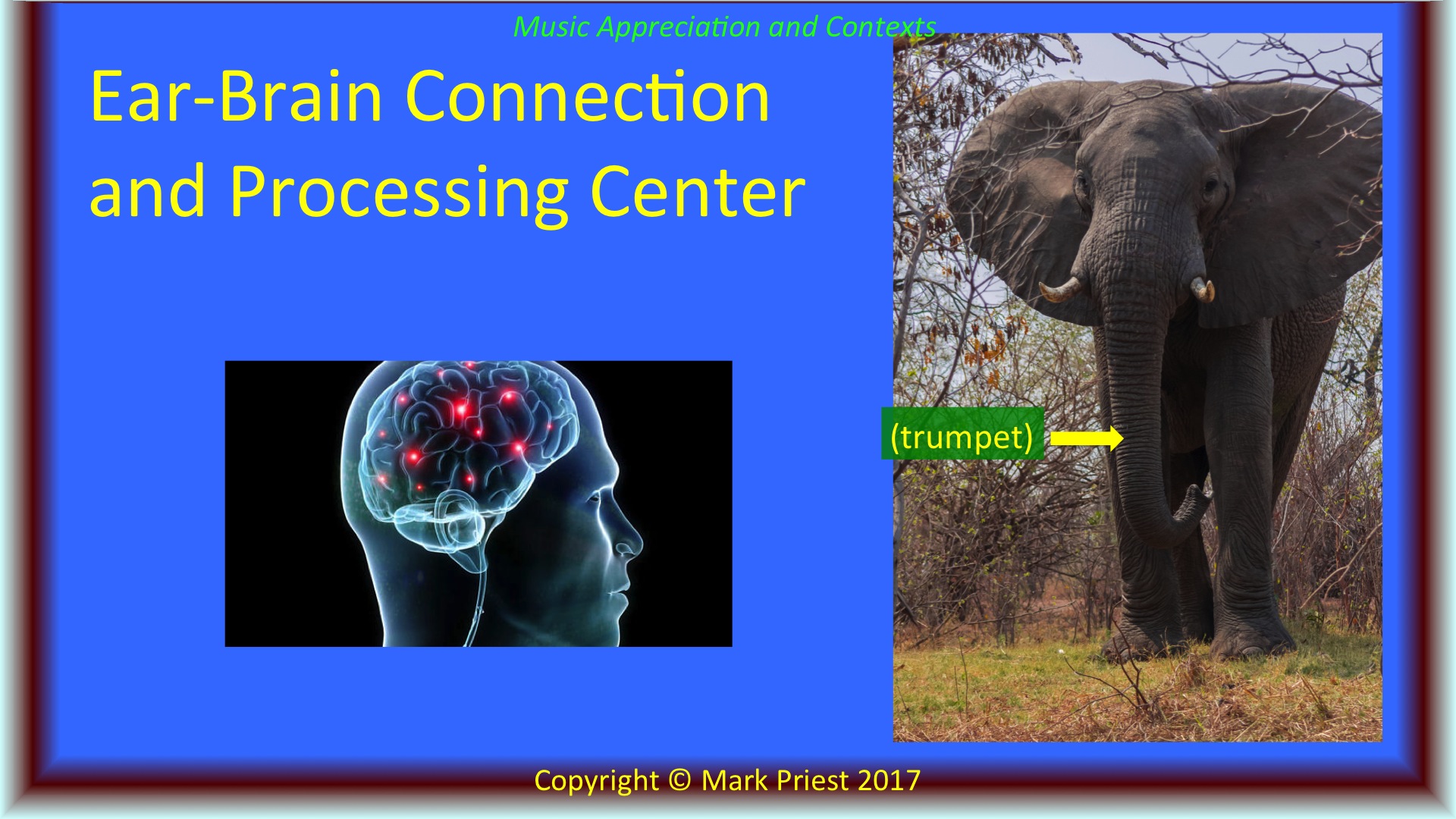
**Perfect Pitch** is NOT required. And you don’t have to be able sit down at a piano-keyboard, and play a song after hearing it only one time!
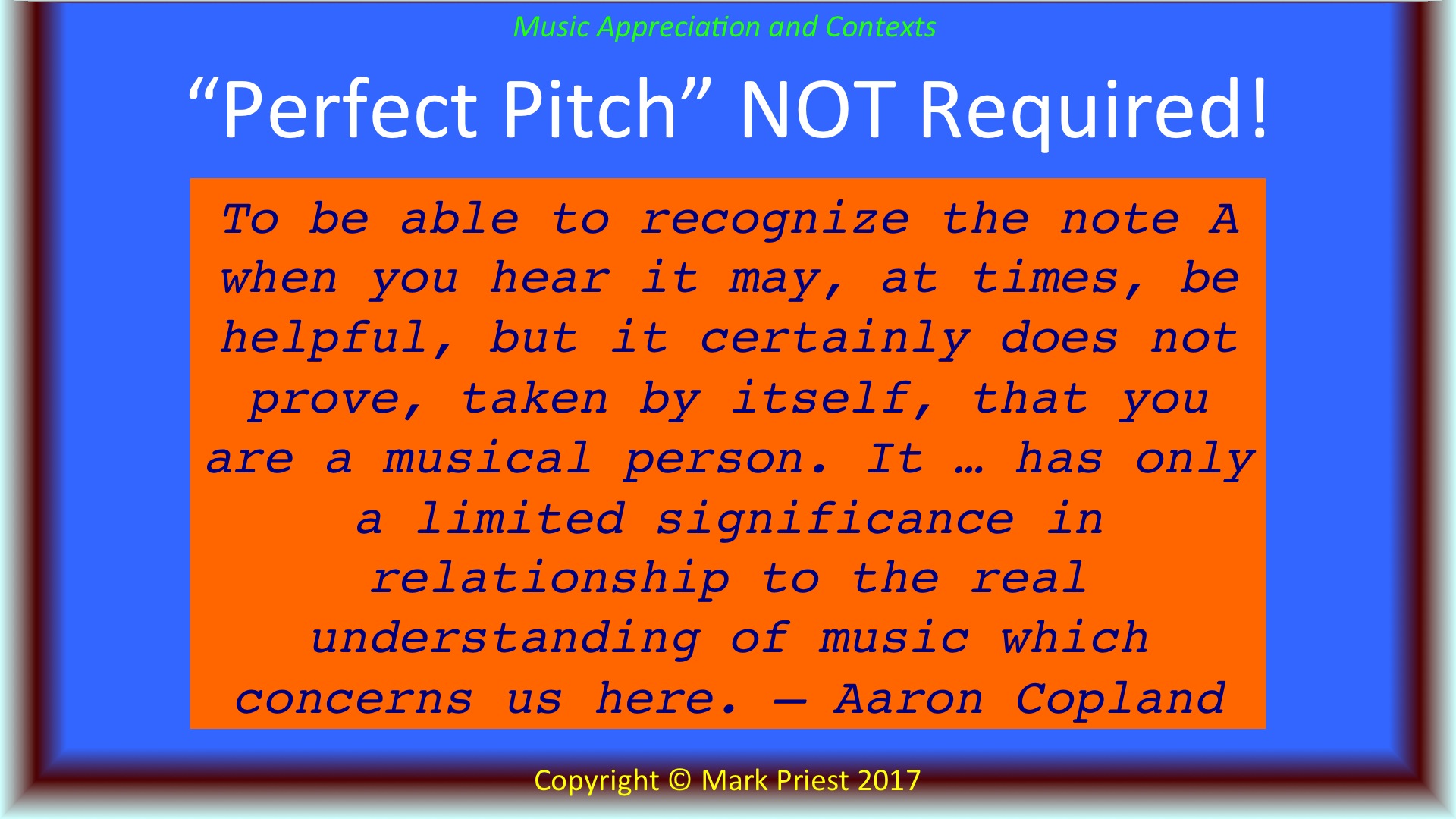
**Minimum Prerequisite:** The ability to recognize a *melody* that you have heard before, when you hear it again. For example, this well-known Public Domain tune: [mus]
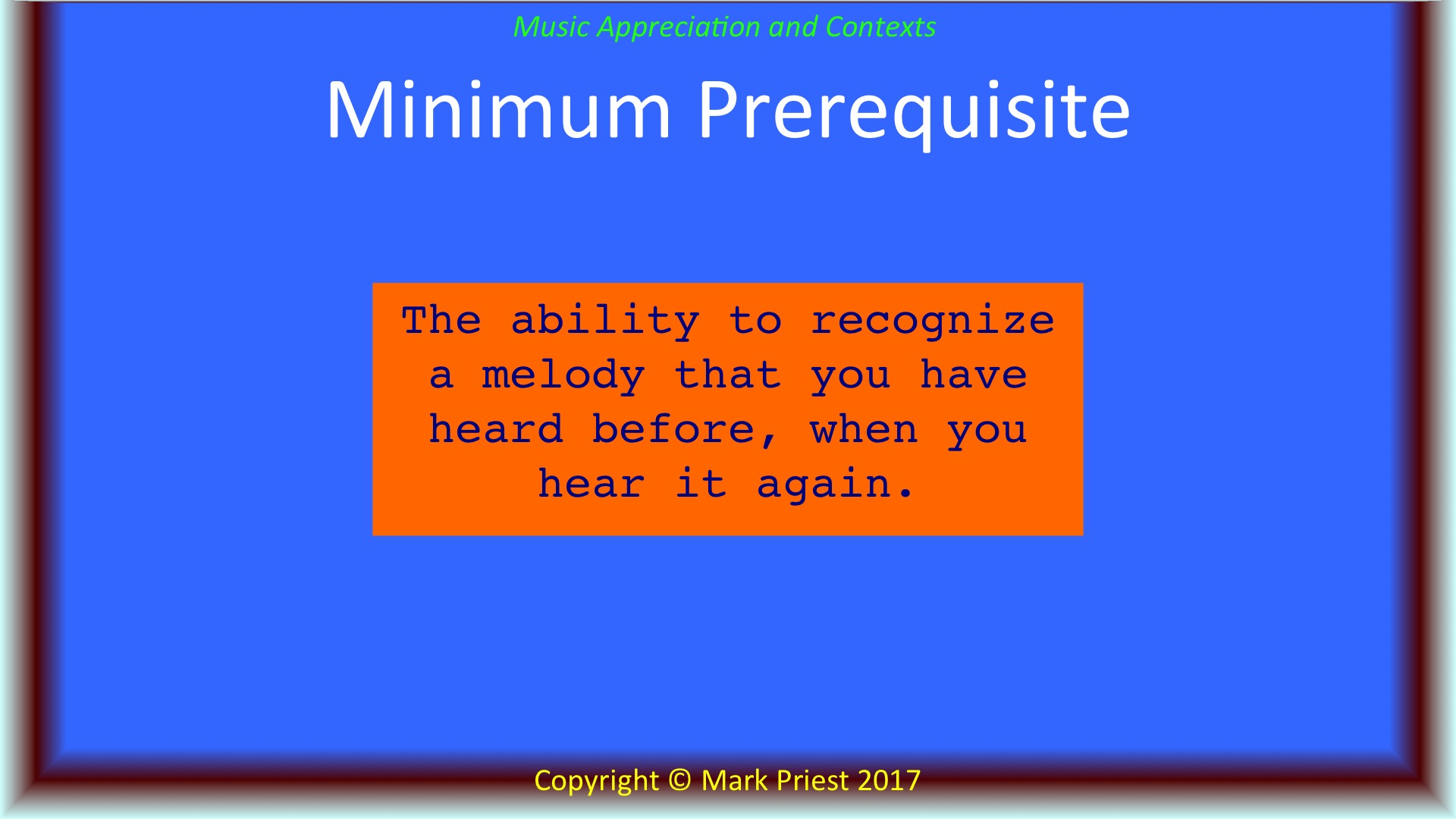
Why is this ability to *remember* a melody so important? Because melodies are like the plot, events and characters of a novel. Someone who cannot recognize a melody when hearing it is like someone who cannot follow the unfolding events of a story. [mus]
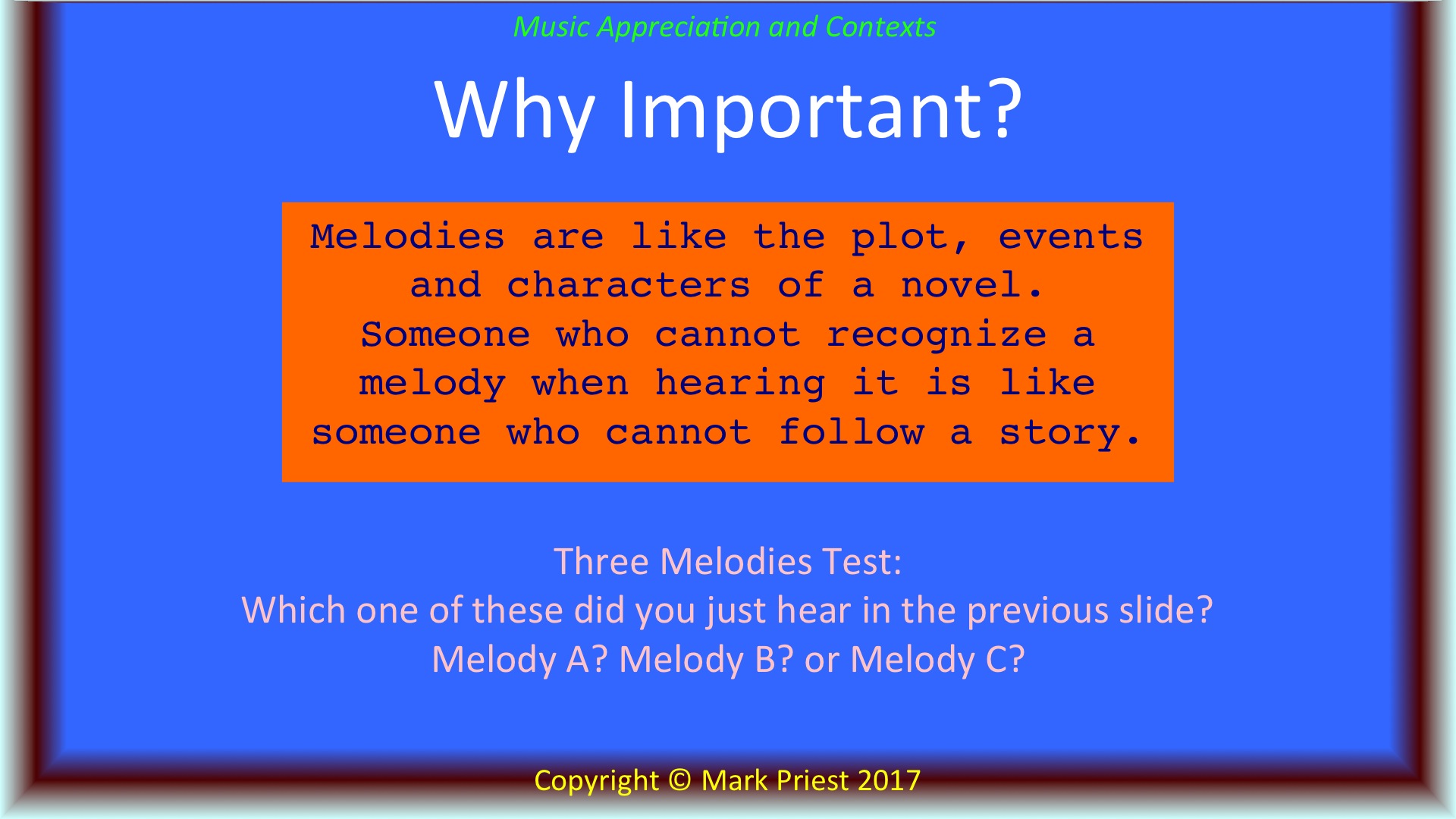
If you said Melody C, which was the song Go Tell Aunt Rhody, you are correct. Now, being a DJ, or musician – i.e., someone who can play tunes on a musical instrument – does not prove “musical intelligence”; many can play musical instruments or DJ, but do not care to know much about the science of music. Perhaps they have another agenda.
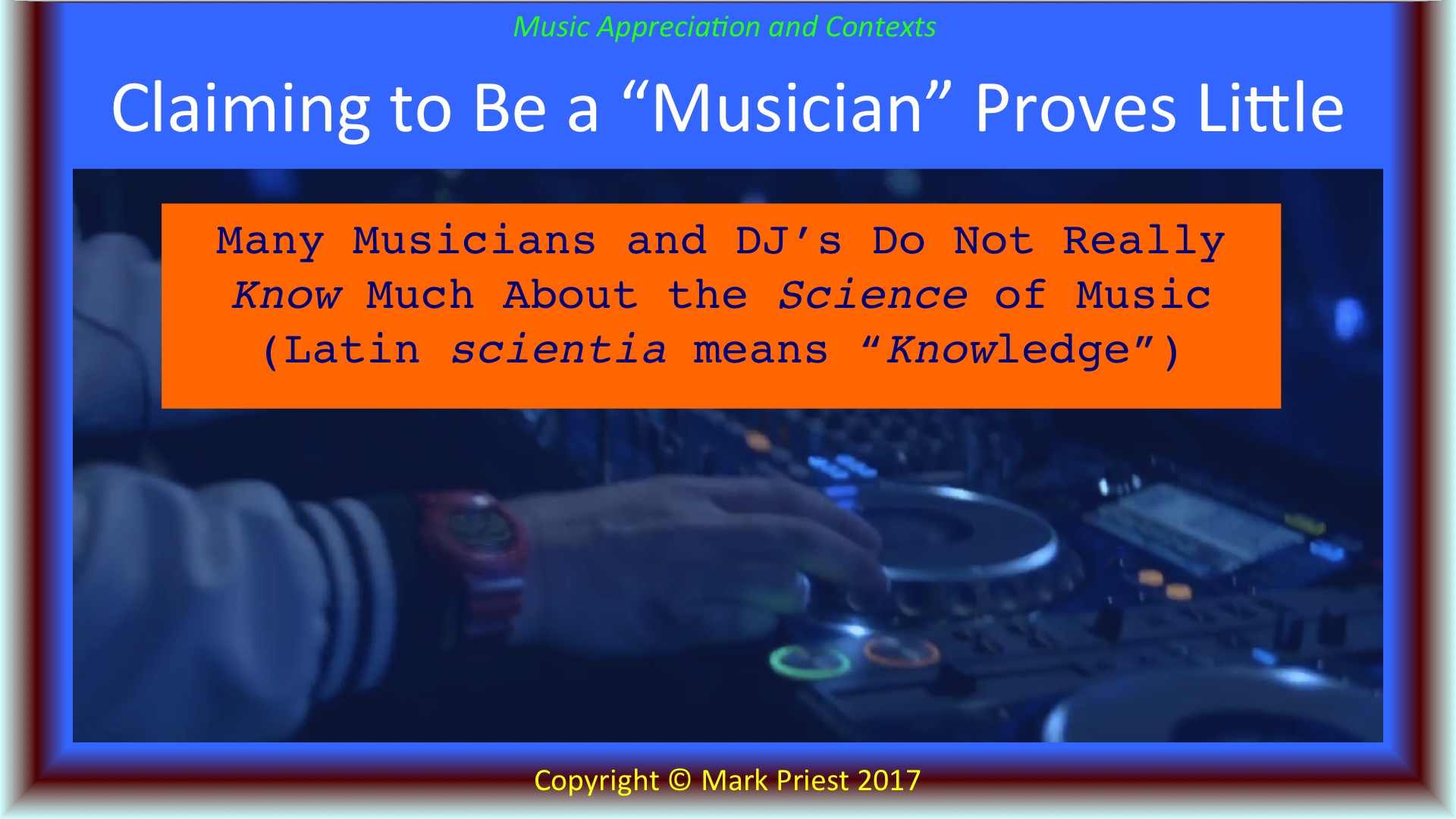
In this course, what we do for you, the listener, is call attention to milestones in the music itself, and context, but to benefit from the analyses, you will have to spend time doing personal listening to the assigned music. There are NO shortcuts or substitutes for the mental “workout.”
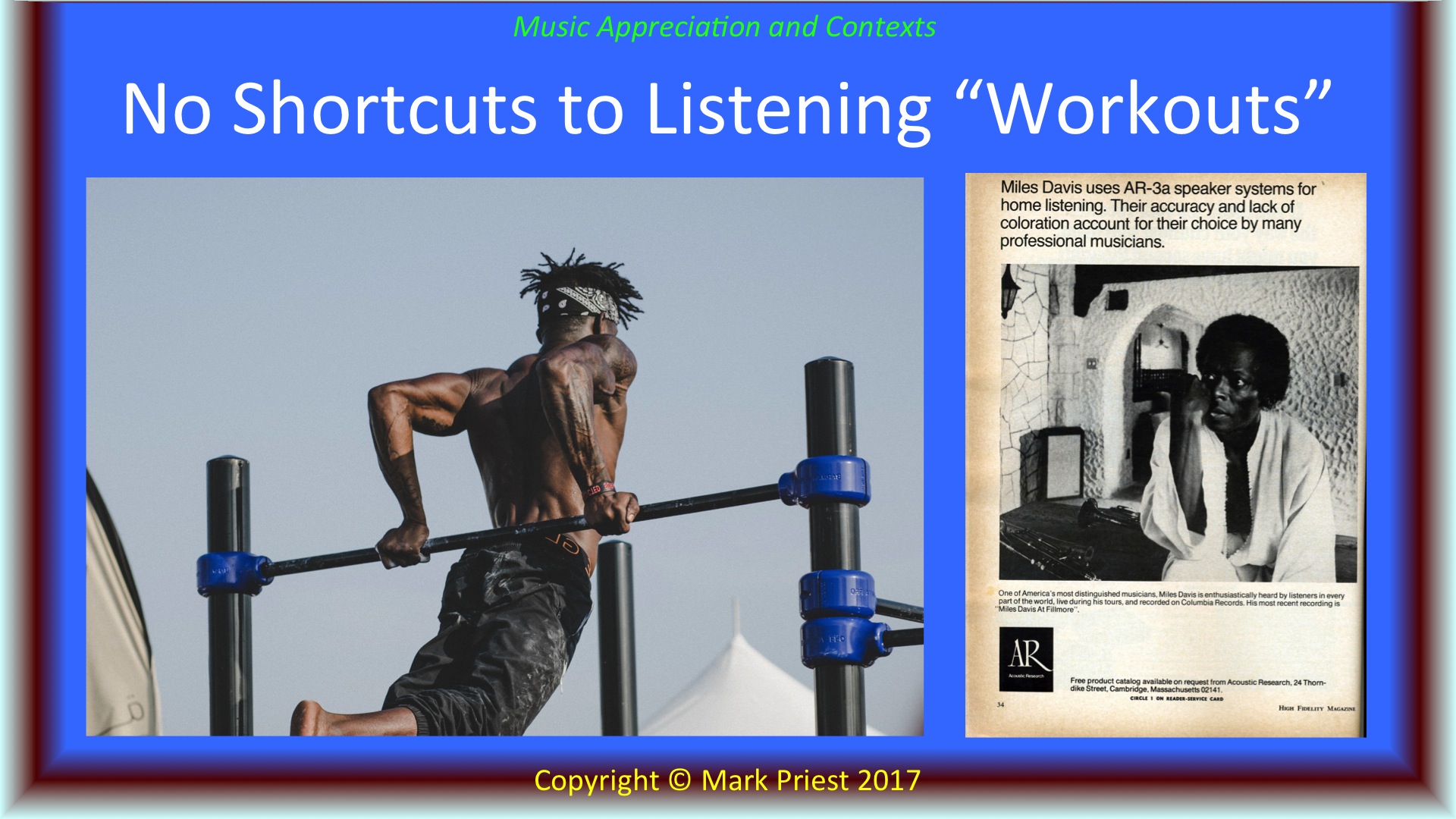
Repeated hearings of the same musical works have proven helpful in developing the ability to recognize melody; the benefits, accrue over time. Think of the Christmas music, which we are bombarded with every holiday season; you recognize the songs, because you’ve heard them over and over again.
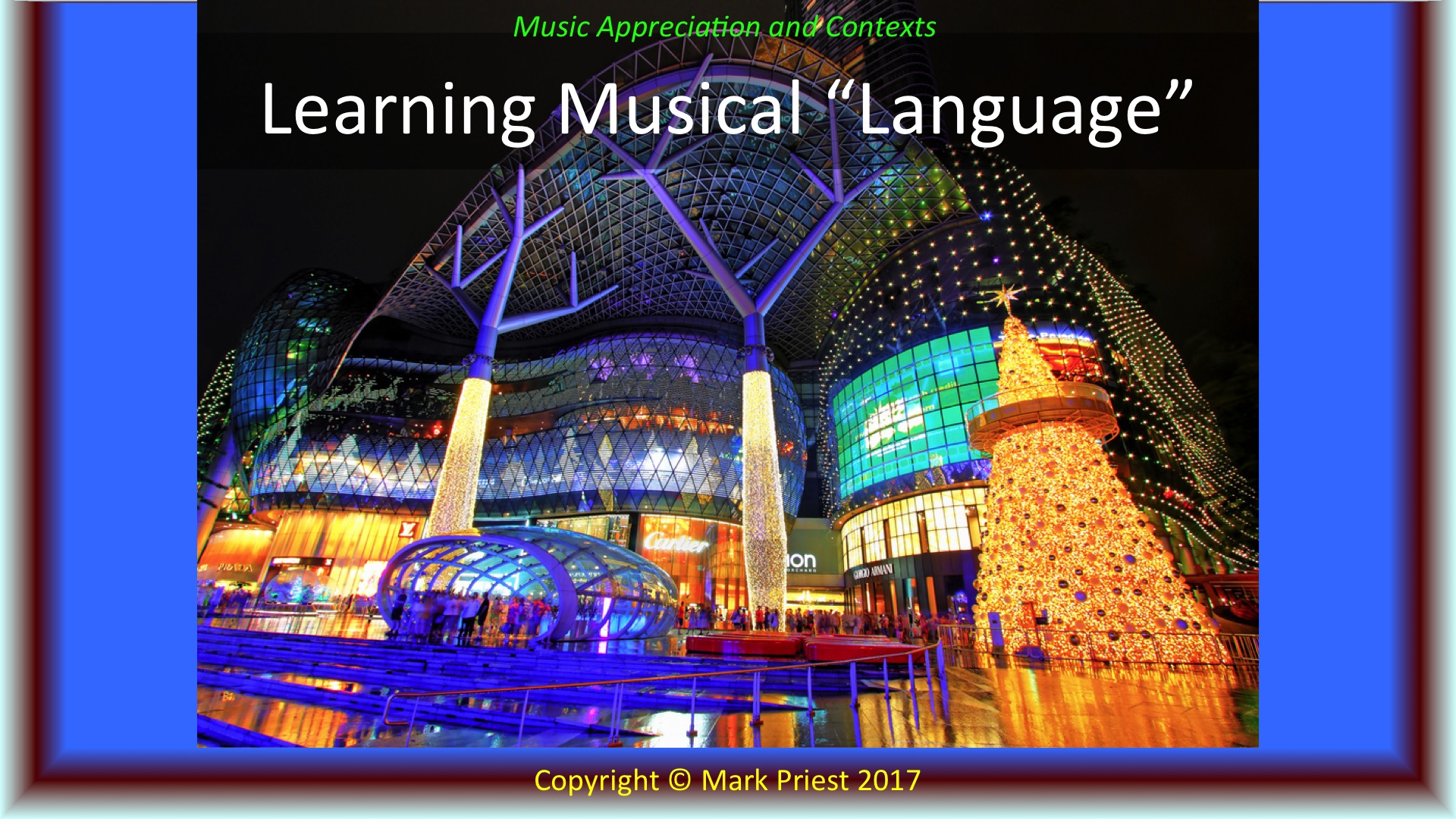
This is also similar to the way we learned to speak: we hear words and sentences repeated over and over in our environment, and received positive feedback from parents, relatives, friends, and neighbors. Music is not produced in a vacuum; there are always historical, geographical, cultural, and personal contexts – the environment – to be considered.
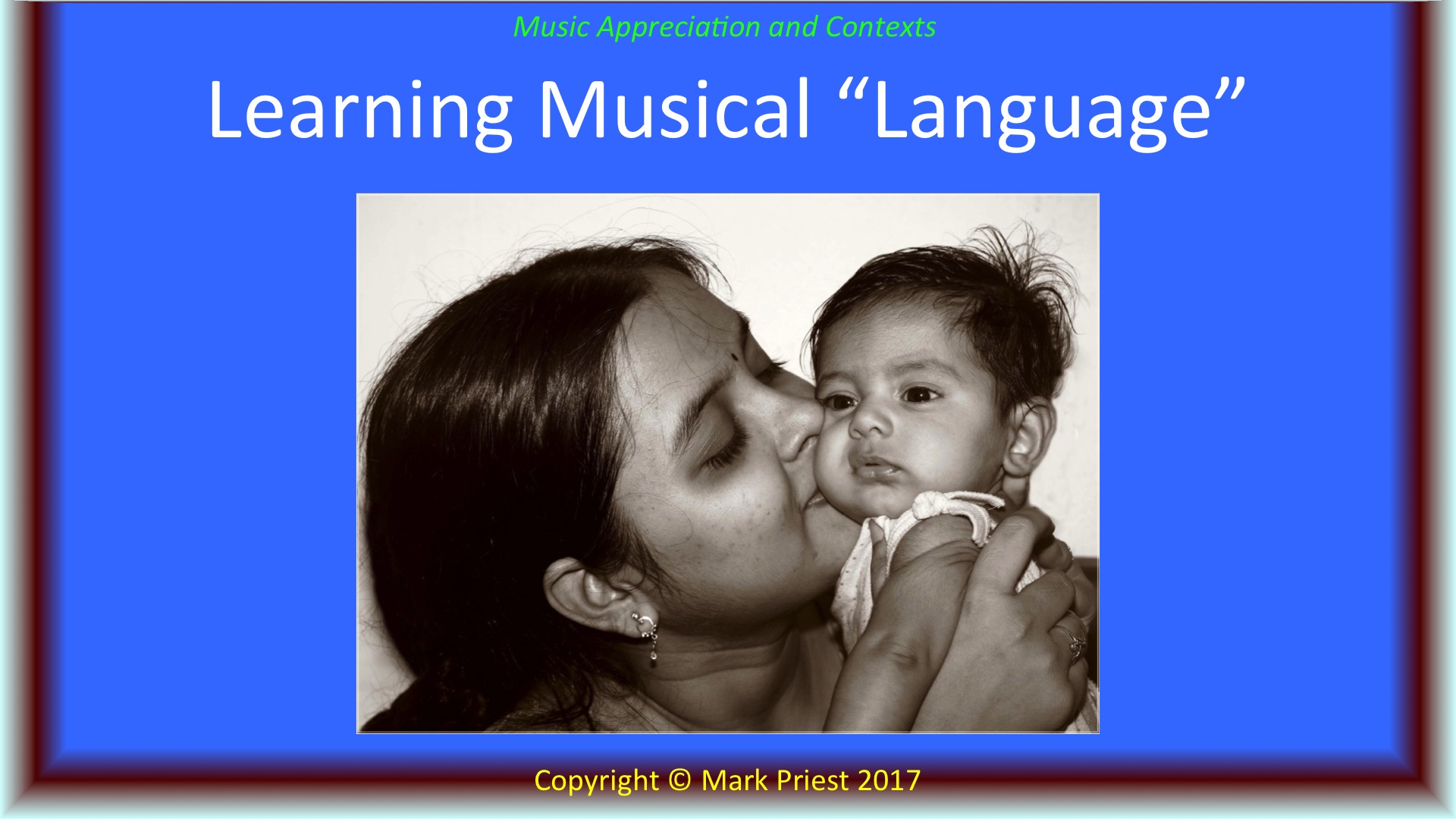
[mus] **Ludwig van Beethoven**, even today one of the most famous and influential composers, was born in Bonn, Germany, and spent most of his life in Germany or neighboring countries, in Europe. His father Joseph, a musician, started young Ludwig studying music. His father was also an alcoholic.
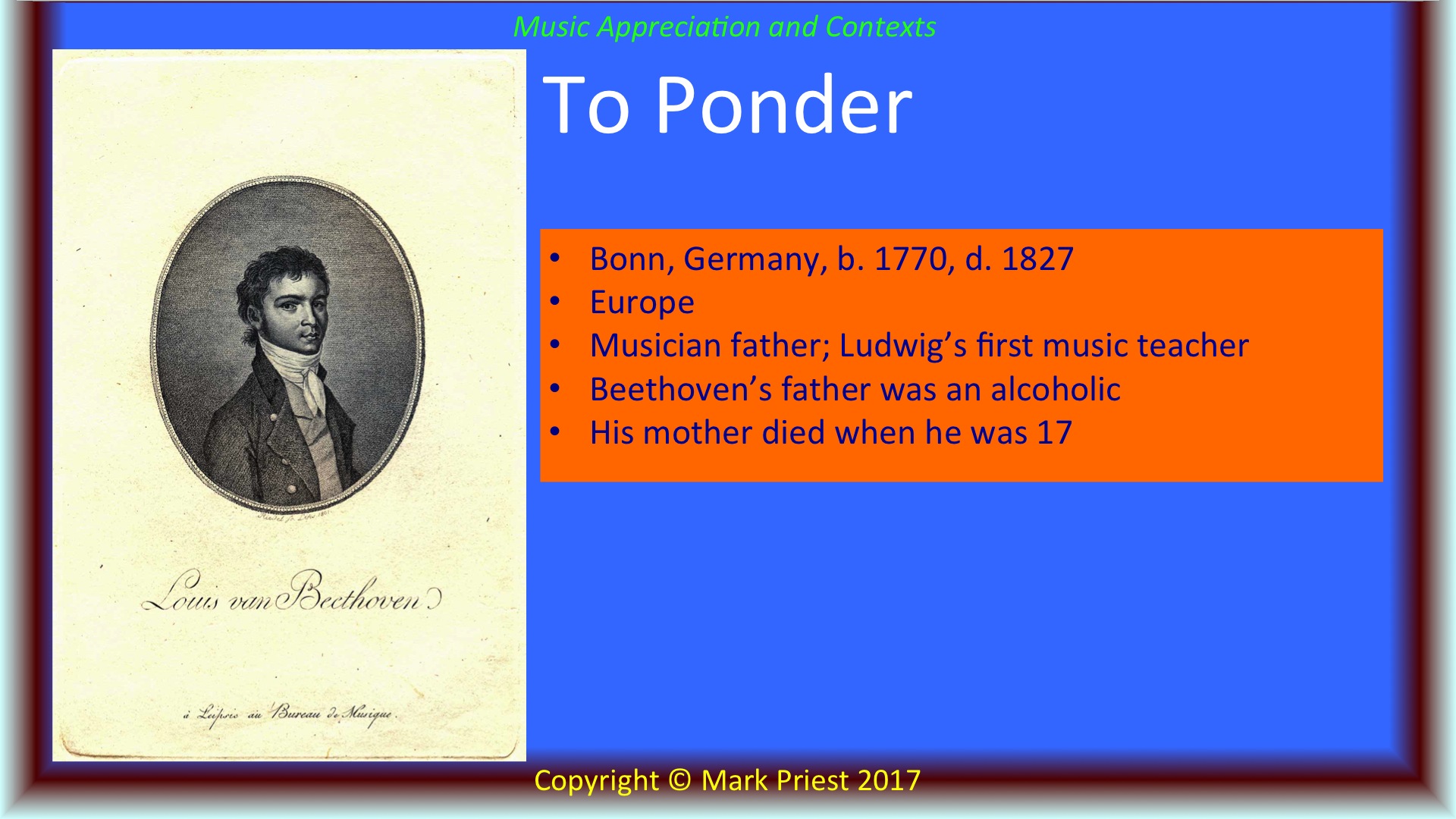
Beethoven lived during a specific time in history – b. 1770, d. 1827 – and as a result was immersed in the social, political, religious, and economic realities of his day – the intellectual and philosophical movement known as **The Enlightenment** dominated Europe. The American Revolution, the French Revolution, and the rise and fall of Napoleon Bonaparte, all occurred during Beethoven’s lifetime.
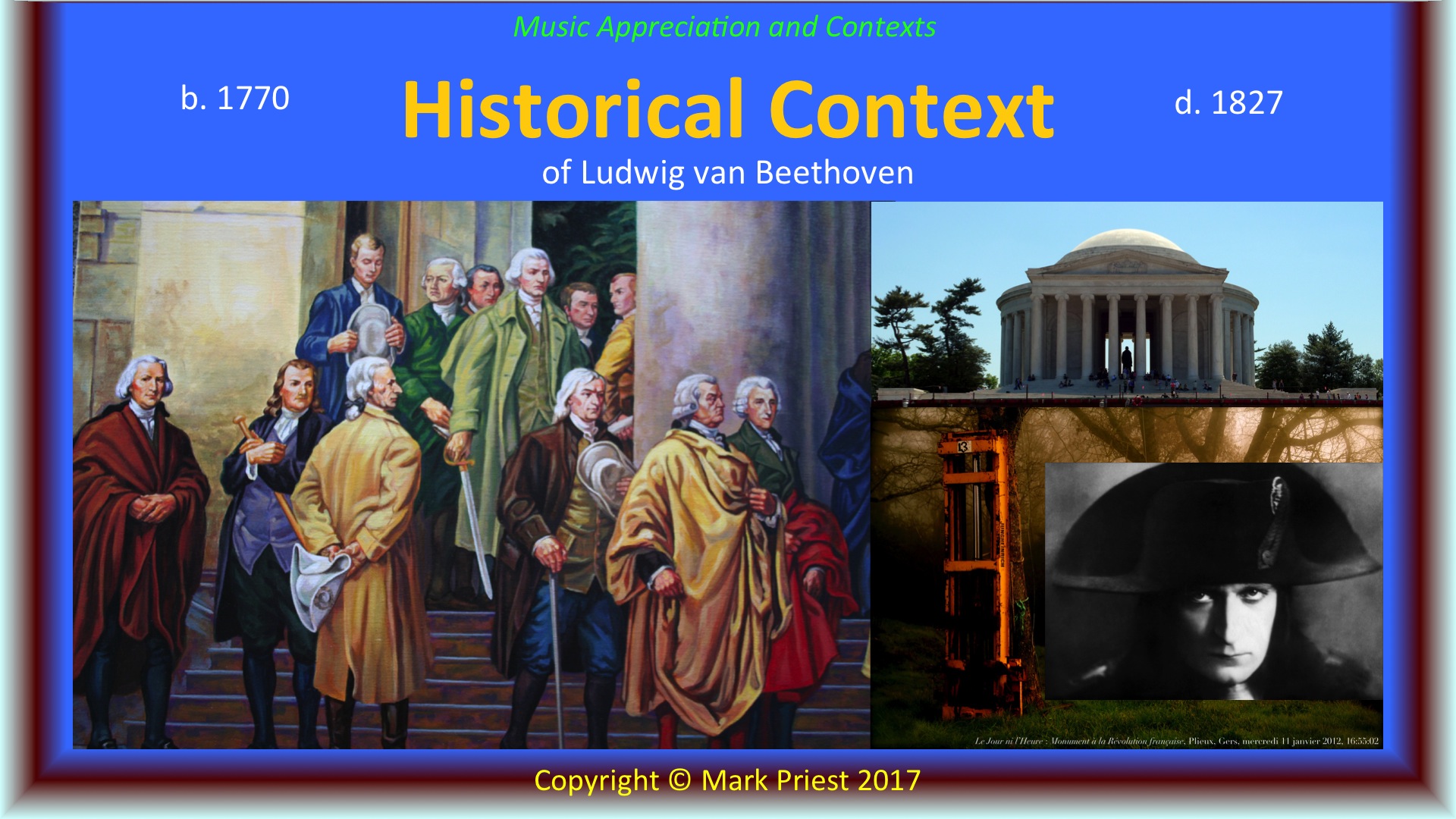
Beethoven had planned for a career as a performing musician – he was a concert pianist – but began losing his hearing during his late twenties. Beethoven had become completely deaf by the time he wrote many of his famous masterpieces. [mus "Ode to Joy" melody]
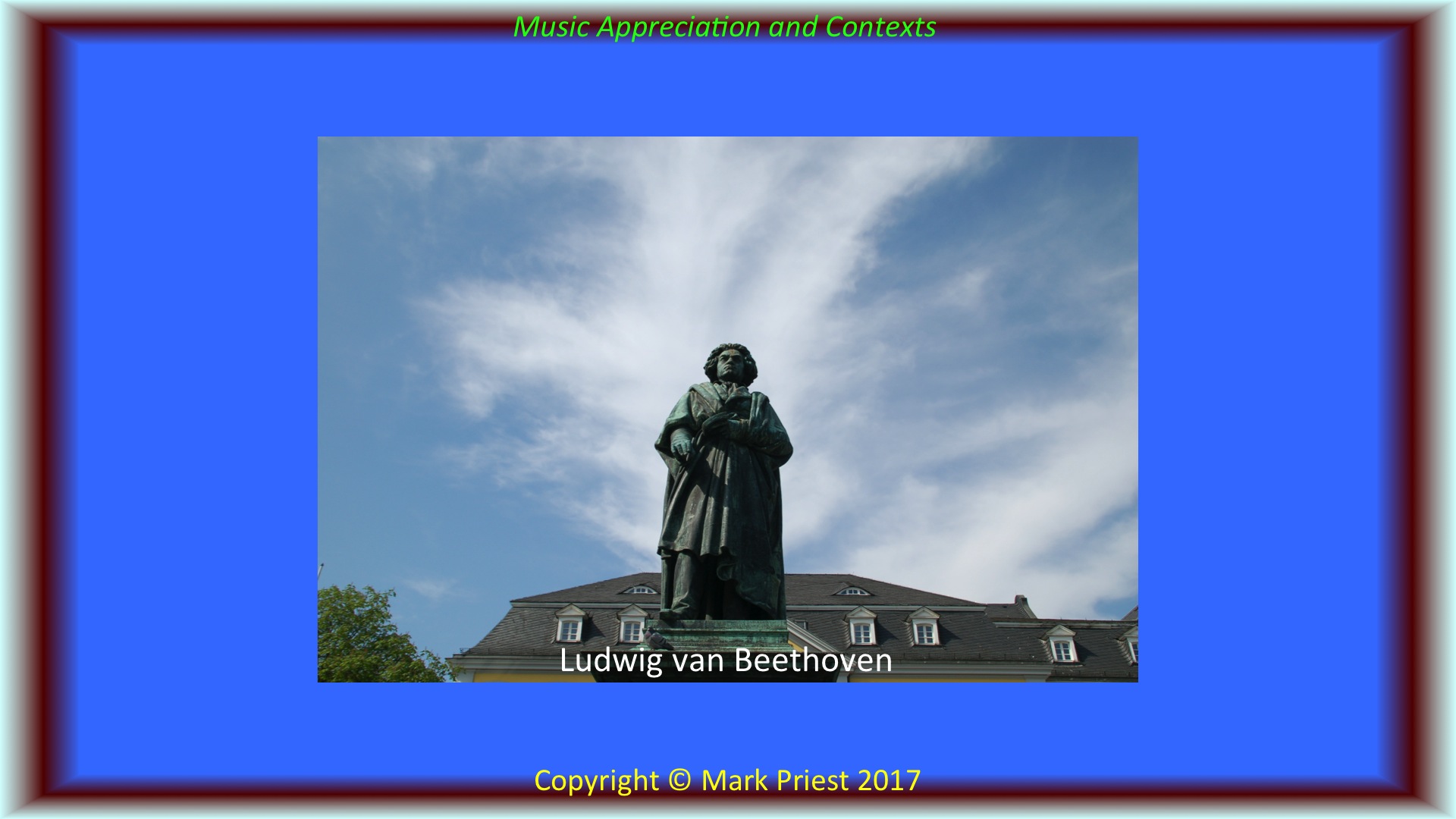
That last melody, known as “Ode to Joy,” is heard in the *Finale* of his **Ninth Symphony**. Composed for large symphony orchestra and mixed chorus, Beethoven, who was present at the inaugural performance of this Symphony, could hear nothing, except what was inside his head.
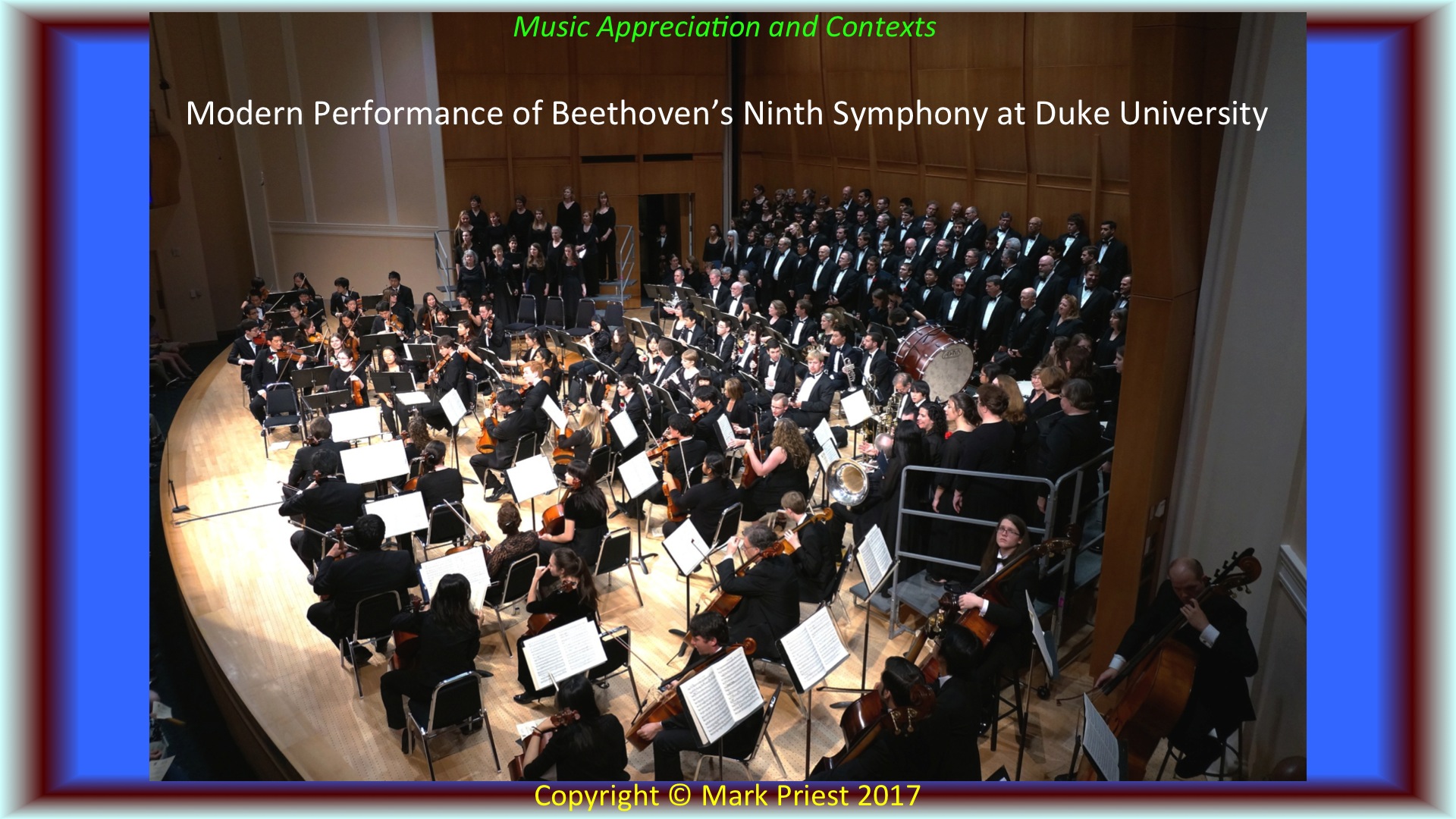
All the aforementioned “contexts” – the historical, geographical, cultural, and personal circumstances – had an influence on Beethoven’s music. Hypothetical Question: Would it have sounded the same if the composer had grown up in another land, say, in Asia? Or on an island in the middle of the ocean, such as Fiji, or Zanzibar?
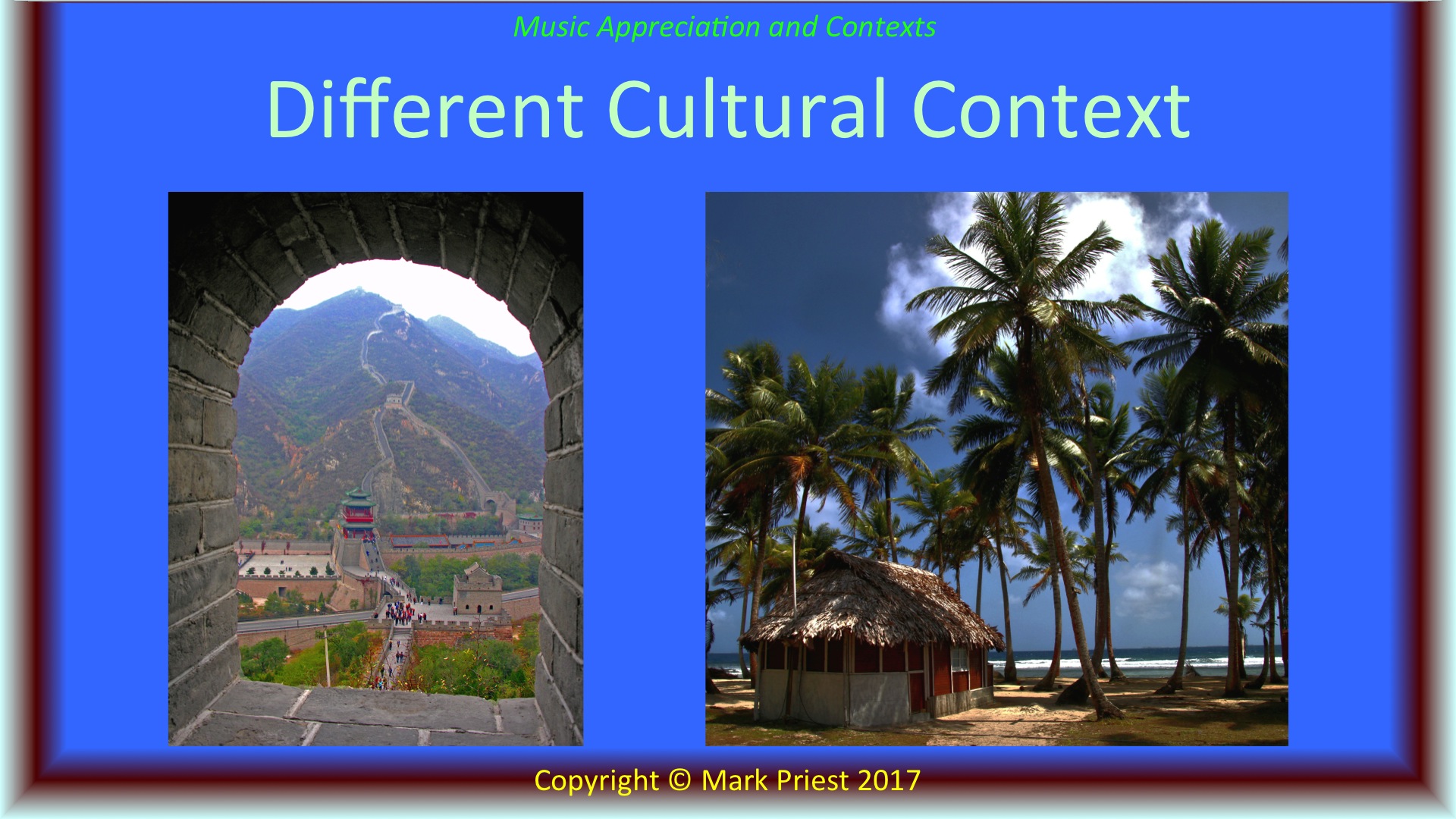
Or at a different time. Say, 4,500 years ago? What type of music would Beethoven come up with, for example, had he grown up in ancient Egypt?
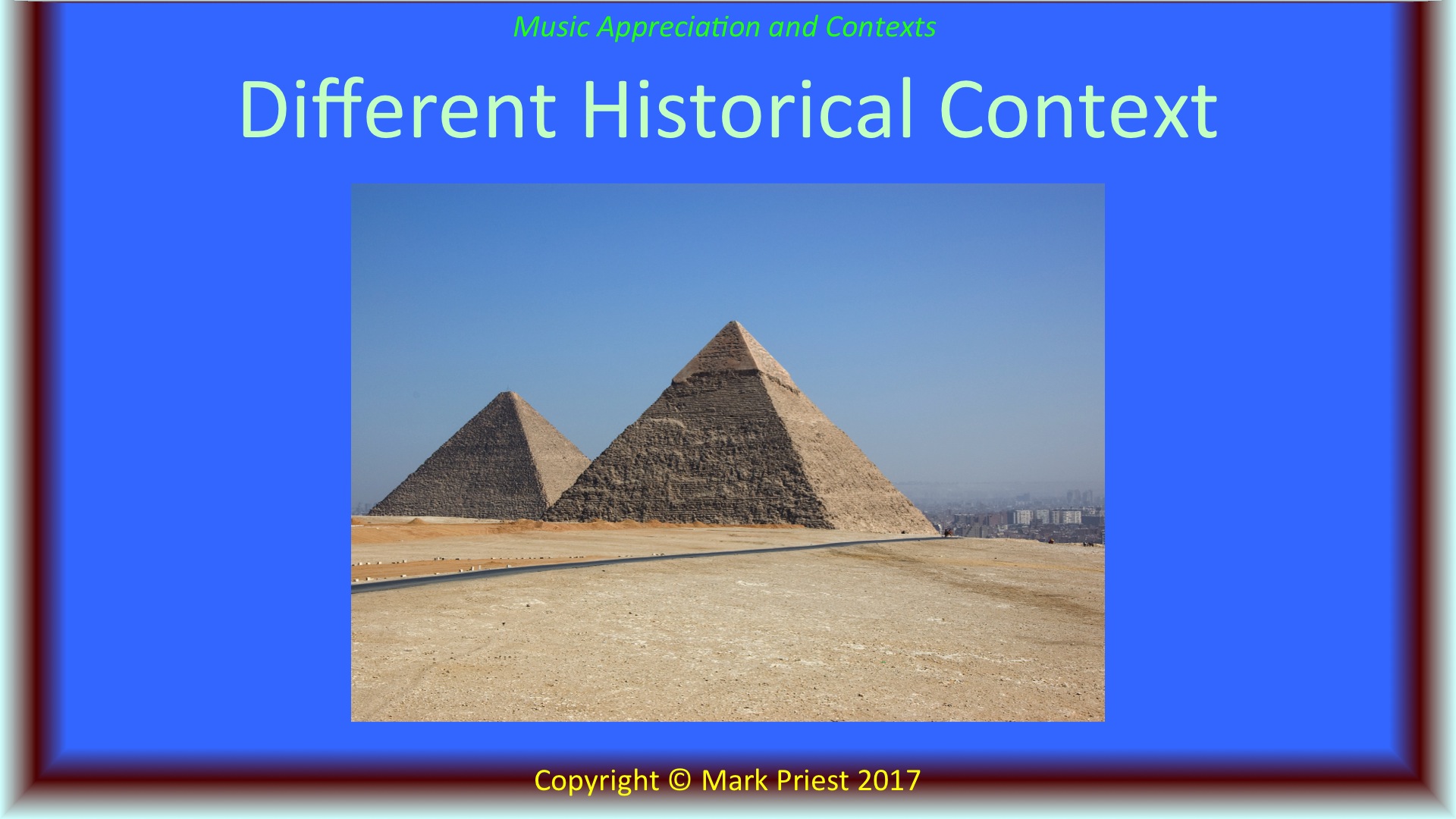
Or suppose Beethoven was living today, with electronic devices such as hearing aids, or perhaps in the future, when there might be a cure for his hearing handicap? Would such changed circumstances – different contexts – have an impact on the composer’s personality, on his music?
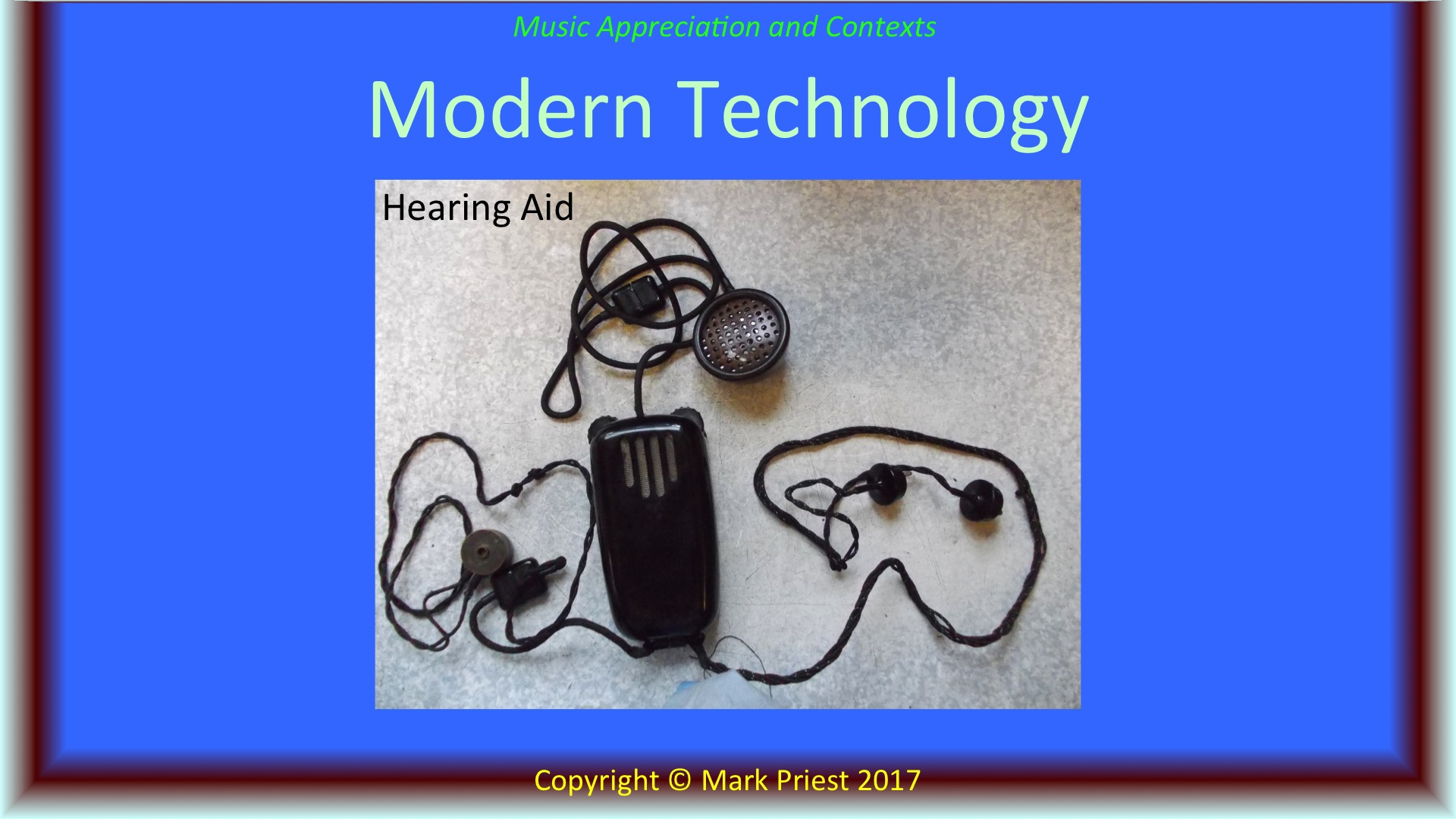
Such are some of the contexts we want to bear in mind while analyzing and learning to appreciate the various types and styles of music we examine. Welcome once more, and keep listening!
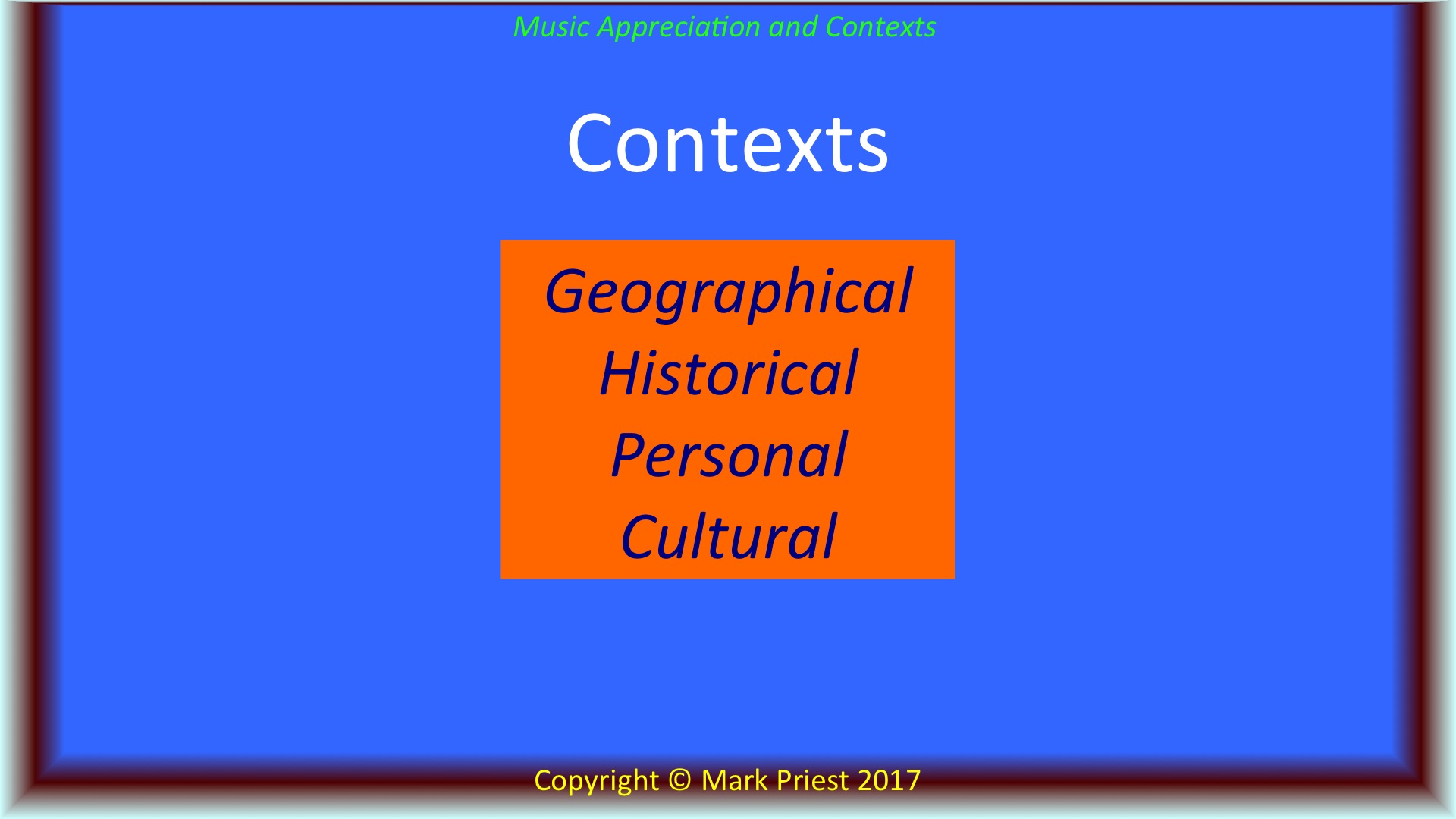
If you “Upvote” this presentation, please Resteem, Share, pose questions in a Comment, and Follow the blog for updates. Thank you for watching the video!
CREDITS, LINKS
Copland, Aaron. *What to Listen for in Music*. Signet; Reissue, 2011.
AUDIO, Freesound: Piano Transition, NenadSimic: https://freesound.org/people/NenadSimic/sounds/169087/
Attribution Lic: https://creativecommons.org/licenses/by/3.0/
AUDIO, Musopen, Public Domain:
Beethoven, Symph. No. 3 (I): https://musopen.org/music/1033/ludwig-van-beethoven/symphony-no-3-in-eb-eroica-op-55/
Public Domain Lic: https://creativecommons.org/publicdomain/mark/1.0/
Beethoven, “Ode to Joy,” PD. Piano performance copyright © Mark Priest 2017.
IMAGES, Flickr, appearance order:
1. Aaron Copland, drawing from photograph, Richard Hurd (mods & commercial use allowed): https://flic.kr/p/h2M3TK
2. Baby w/ headphones, Gideon Tsang (mods & commercial use allowed): https://flic.kr/p/DXLno
3. Cassette Tape Man, Thomas Galvez (mods & commercial use allowed): https://flic.kr/p/aCwwrz
4. So Many Thumb Drives, Mark Wilson (mods & commercial use allowed): https://flic.kr/p/e6f4Jm
5. Mobile phones or MP3 Players, Justin Pickard (mods & commercial use allowed): https://flic.kr/p/dLQAFB
6. Game Audio, Iwan Gabovitch (mods & commercial use allowed): https://flic.kr/p/p7j5sR
7. Shakespeare Statue, Scott Rettberg (mods & commercial use allowed): https://flic.kr/p/9L7n
8. Elephant!, Andrew Moore (mods & commercial use allowed): https://flic.kr/p/giDknN
9. Brain 18, Affen Ajlfe at www.modup.net/ (mods & commercial use allowed): https://flic.kr/p/RXUck2
10. DJ, Philipp (mods & commercial use allowed): http://tinyurl.com/y9tevyet
11. Workout, Hamza Butt (mods & commercial use allowed): https://flic.kr/p/VCr39u
Hamza Butt’s Site Credit URL: http://www.buynothingnew.org/2017/06/sole-treadmill-reviews.html
12. Miles Davis uses Ar-3a speaker systems ... 1971, Jussi (mods & commercial use allowed): https://flic.kr/p/9KMmy1
13. Xmas Shopping in Singapore: 'Tis the Season (to Spend Money), Wenjie, Zhang (mods & commercial use allowed): https://flic.kr/p/aQct5g
14. Mother & Daughter, Asim Chaudhuri (mods & commercial use allowed): https://flic.kr/p/9SrEnu
15. Louis van Beethoven, Skara kommun (mods & commercial use allowed): https://flic.kr/p/aRiXYn
16. Declaration of Independence_details_three, Stan Faryna (mods & commercial use allowed): https://flic.kr/p/4CWFMW
17. Le Jour ni l'Heure 4282 - Monument a la Revolution française, Renaud Camus (mods & commercial use allowed): https://flic.kr/p/bbCSNa
18. Napoleon, Breve Storia del Cinema (mods & commercial use allowed): https://flic.kr/p/pTzabF
19. Jefferson [Memorial], David B. Gleason (mods & commercial use allowed): https://flic.kr/p/9vxYPR
20. Beethoven, Sven Wusch (mods & commercial use allowed): https://flic.kr/p/9xuN39
21. Beethoven's 9th Symphony performance at Duke University, Duke Arts (mods & commercial use allowed): https://flic.kr/p/mSrFuV
22. China-6401 - Great Wall, Dennis Jarvis (mods & commercial use allowed): https://flic.kr/p/4nACsY
23. San Blas, Sur l'Isla Aguja, Guillaume Baviere (mods & commercial use allowed): https://flic.kr/p/S7jM6y
24. Great Pyramid of Giza, Keith Yahl (mods & commercial use allowed): https://flic.kr/p/7AiuvB
25. Complete Unit [Hearing Aid], tony_duell (mods & commercial use allowed): https://flic.kr/p/oLVH5p
Creative Commons Lic: https://creativecommons.org/licenses/by/2.0/legalcode
 hiveblocks
hiveblocks